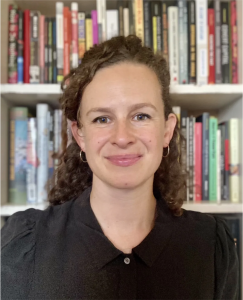

Carlos Alonso Nugent and Emma Shaw Crane were awarded the 2022 Annette Kolodny Prize, given by the Environmental Justice Caucus, and awarded to the best environmentally-themed paper presented at the annual American Studies Association Meeting.
Excerpt from the announcement:
The Annette Kolodny Prize Committee of the ASA Environmental Justice Caucus is proud to announce the winners of the 2022 Kolodny Prize for Best Environmentally-Themed Paper at the Annual ASA Meeting: Emma Crane and Carlos Alonso Nugent. These two winners presented deeply researched and theoretically sensitive papers about places produced by war and colonial border conflict.
Emma Shaw Crane for “Lush Aftermath: Labor, Landscape, and War in the Suburb”
Emma Shaw Crane’s paper situates us in Homestead, Florida, home to a military base, a detention camp for migrant children, and a military Superfund site: a place “produced by war,” as Crane writes. Crane connects these martial sites with their unlikely near neighbors: ornamental plant and palm nurseries staffed largely by Maya migrants from Guatemala. Deploying theories of racism by Ruth Wilson Gilmore and Jodi Melamed, Crane explores the suburb of Homestead, Florida as a constellation of sites that seem separate, but are in fact intimately connected as products of war. Working from extensive ethnographic research, Crane argues that landscapes of war need to be understand as both “ruinous, destructive, and disordered” and also as “ordered, lucrative, and lush.”
Carlos Alonso Nugent for “Mescalero Apache Imagined Environments across the US-Mexico Borderlands”
Carlos Alonso Nugent’s paper excavates the work of the Binational Boundary Commission, created after the U.S.-Mexico War of 1846-1848. This commission of explorers and engineers created a wide array of borderland media: charts, sketches, fieldnotes, maps, formal reports, and—significantly—representations of Mescalero Apache and Chihene Apache art that reveal alternative ways of dwelling in and representing the desert. Nugent reads the work of the Boundary Commission’s as a colonialist “struggle against harsh terrain, but also against imagined environments”: namely the imagined environment of the Apache. The Boundary Commission’s report inadvertently brought to light, preserved, and recirculated Apache epistemologies, acts of resistance, aesthetics, and ecological knowledge. The survival of these ecomedia helps us see, as Nugent demonstrates, how “this Indigenous imagined environment has moved beneath and beyond its settler counterparts.”

